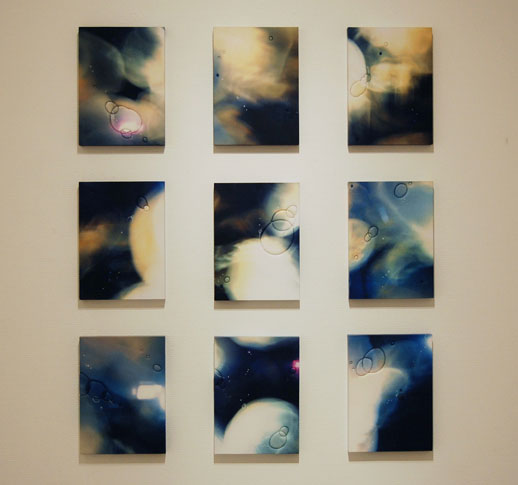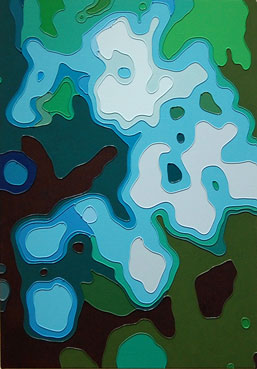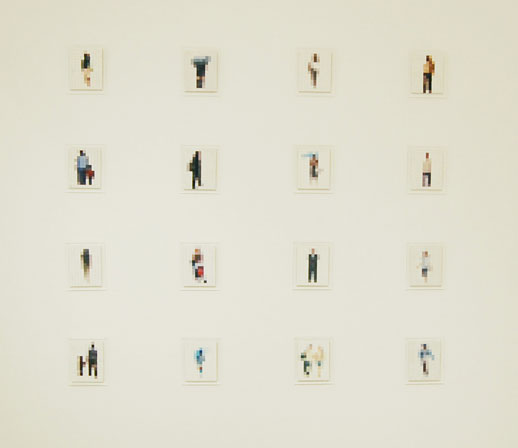Escaping the Veneer
Although the exhibition title is “EX-SURFACE” in English, its Japanese characters mean “expanding interface” (as in the interface between two liquids), evoking thoughts of fluidity and transience appropriate to the works on display. This compact exhibition consists of nine engaging paintings, through which each artist generates his or her own interpretation of the mechanics of the picture plain. The featured artists have been brought together for their shared approach to adopting an unconventional array of textures, colours and materials; the works have been emancipated from two dimensional conventions and attempt to leap forth into the gallery space.

These works are very sensual: you find yourself struggling to overcome an almost overwhelming urge to run your fingers over the surface of each and every piece. A set of paintings by Hitomi Iwano provides an ideal example of this tactility. Made with both modern and traditional Japanese techniques, her beautiful, watery photographic abstractions have been printed onto cloth, and then applied to separate, sculpted styrofoam canvases using kimekomi, a technique taken from traditional Japanese doll-making. This probably provides one of the more obvious examples on how the artists in this group, though punchy and uncompromisingly modern in their approach, seem to also be able to incorporate the more subtle elements of Japanese aesthetic tradition.
![Photo courtesy of Artlantico Gallery Junji Shiotsu 'Hamon (25 piece)' (2008) Acrylic resin, polyvinyl chloride, mirror film; 171 x 171 x 5.3cm [On the right: works by Tomoya Tsukamoto]](http://www.tokyoartbeat.com/tablog/entries.en/wp-content/uploads/2008/06/ex-surface2.jpg)
Nearby Junji Shiotsu’s Hamon features an intricate pattern of white blossoms, made with completely different materials but achieving a similar effect of fluidity. The work creates a dynamic harmony with the surrounding space through the layering mirrored glass and transparent vinyl panels; its elusive monochromatic motifs shimmer in and out of sight as you move around it. Next to it, a painting by Taro Morimoto echoes the floral motifs with a novel use of bold, simple forms rendered in a thick acrylic veneer.

In the space between Shiotsu and Iwano’s work, the white and blue petals of Tomoya Tsukamoto’s Underwater Forest and Puzuru shimmer in a different way. The work is given both depth and buoyancy by Tsukamoto’s combination of simple, bold chromatic colours and meticulous brushwork, creating an abstract though very tangible sensation of spatial depth. The forms seems to come from nature but their contrast with the bright, unyielding colour scheme brings a tension to the surface of the work, as though the scene threatens to burst out of its already frail frame.
These works all convey the idea of burgeoning surfactants, operating not only on an aesthetic or technical level but also on a more symbolic level, exploring the semantics of the concept of “surface”. One cannot help feeling that all these pictures, these surfaces, these layers, are in fact of both concealing and revealing a world that consists purely of masks and facades. A world that positively thrives on refined perceptions of reality. For example, Kei Imazu’s large neon-bright painting Prizes, depicts a boy floating or perhaps swimming over a fluidic and chromatic consumer paradise, a sprawling supermarket that spreads up to and beyond the edge of the canvas. He seems to be holding his breath, and his environment is abundant and enriched but also overwhelming and devoid of warmth.

Takeshi Abe has constructed a series of panels made of individually painted wooden cubes which, stacked in a grid, reveal blurred human forms. Abe’s pixelated figures conjure up a very contemporary kind of daydream, a world populated by digital ghosts, reminiscent of faceless figures that flicker on CCTV footage, fading in and out of their digital existence. Like Imazu and the others he also seems to be exploring the surfaces that define his own world, where we are all subject to the influence of society’s continuous reams of artifice and facsimile, the abyss that ripples, trickles and swells just in front of the camera lens and behind the cathode ray tube. These works are characterized by a sense of longing in the reconciliation between that which is bold, modern and industrial and that which is organic, delicate and subtle. It is in essence the surface below which the conflicted enigma of the Japanese experience resides.
Andrew Woodman
Andrew Woodman



